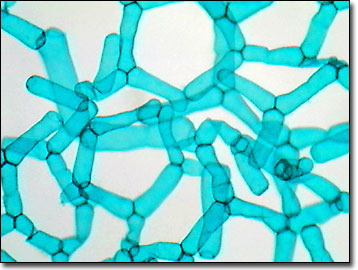Brightfield Digital Image Gallery
Hydrodictyon Green Algae
In the green algae division Chlorophyta, members of the genus Hydrodictyon (the water nets) are sometimes considered weed or pest organisms because they are so prolific that they can overwhelm aquaculture facilities, lakes, irrigation ditches, and even rice fields, especially where introduced as alien water plants. Sexual and asexual reproduction are possible among these colonial green aquatic plants.

Hydrodictyon algal cells are typically arranged in pentagons or hexagons. Rapid reproduction occurs when each cell in the cylindrical net produces a new cylindrical net of small cells, contained within its own cellular structure. After escaping from the parent cell, the miniature net grows tremendously, and once again, each cell produces another miniature net. Provided the optimal growing environment, some colonies of Hydrodictyon are capable of reaching lengths up to 8 inches (or 20 centimeters). Although sporadic in distribution throughout water bodies, once established, this alga type can become quite abundant and is considered, in many cases, a nuisance plant species. The extensive nets or mats of Hydrodictyon serve as important refugia for aquatic invertebrates such as cladocerans, leeches, snails, and some beetle larvae.
The life cycle of this green alga is well studied, with asexual propagation occurring via zoospores formed simultaneously en masse. Although the zoospores are outfitted with two flagella, they barely move, perhaps because of the extremely dense packing. A cell wall is formed by the zoospores, the mass becomes cylindrical, and they arrange themselves into a miniature version of the water net. At this point, the mother cell disintegrates and the daughter net is freed, although it is microscopic. Under favorable conditions for growth, several hundred new nets are formed as each of their cells starts forming daughter nets. Subsequently, there is an algal bloom or explosion, particularly in enriched (eutrophic) waters, and hundreds of thousands of new nets are liberated.
Isogametes that are smaller than the zoospores, but also generated in incredible numbers, are responsible for propagating Hydrodictyon sexually. A hole occurs in the cell wall of the mother cell and the gametes escape into the water column. A zygote results from the fusion of two gametes and subsequently produces a thick cell wall and becomes angular. After resting, two to five large zoospores form from this sexual offspring and then enlarge into polygonal cells. Division of the protoplasm of these cells creates new zoospores that drop their flagella and construct a new net by lying side by side with each other.
Contributing Authors
Cynthia D. Kelly, Thomas J. Fellers and Michael W. Davidson - National High Magnetic Field Laboratory, 1800 East Paul Dirac Dr., The Florida State University, Tallahassee, Florida, 32310.
BACK TO THE BRIGHTFIELD IMAGE GALLERY
BACK TO THE DIGITAL IMAGE GALLERIES
Questions or comments? Send us an email.
© 1995-2025 by Michael W. Davidson and The Florida State University. All Rights Reserved. No images, graphics, software, scripts, or applets may be reproduced or used in any manner without permission from the copyright holders. Use of this website means you agree to all of the Legal Terms and Conditions set forth by the owners.
This website is maintained by our
Graphics & Web Programming Team
in collaboration with Optical Microscopy at the
National High Magnetic Field Laboratory.
Last Modification Friday, Nov 13, 2015 at 01:19 PM
Access Count Since September 17, 2002: 32139
Visit the website of our partner in introductory microscopy education:
|
|
